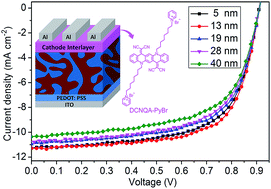N-type cathode interlayer based on dicyanomethylenated quinacridone derivative for high-performance polymer solar cells†
Abstract
A new π-conjugated electrolyte bis(dicyanomethylene)-quinacridone with two octyl-pyridium (DCNQA-PyBr) has been synthesized and employed as a solution-processed cathode interlayer (CIL) for polymer solar cells (PSCs). The devices exhibited simultaneously increased open-circuit voltage (Voc), short-circuit current (Jsc) and fill factor (FF). Overall, the PSCs with PCDTBT (poly[N-9′′-heptadecanyl-2,7-carbazole-alt-5,5-(4′,7′-di-2-thienyl-2′,1′,3′-benzothiadiazole)]) as a donor and PC71BM ([6,6]-phenyl C71-butyric acid methyl ester) as an acceptor incorporating a 13 nm DCNQA-PyBr interlayer exhibit a power conversion efficiency (PCE) of 6.96%, which is 1.3 times of that of the Al-only device. Most importantly, compared to the reference π-conjugated electrolyte QA-PyBr, DCNQA-PyBr shows much improved electron transport ability and conductivity. As a result, the DCNQA-PyBr based devices only show a slight decrease in electron transport upon increasing the thickness of the CIL, thus allowing a high PCE with a wide CIL thickness range from 5 nm to 40 nm. Furthermore, introducing DCNQA-PyBr as a CIL into the devices based on P3HT:PC61BM (P3HT = poly(3-hexylthiophene), PC61BM = [6,6]-phenyl C61-butyric acid methyl ester) and PTB7:PC71BM (PTB7 = polythieno[3,4-b]-thiophene-co-benzodithiophene) also leads to significantly enhanced device performance, showing high PCEs of 3.91% and 8.23%, respectively. These results confirm DCNQA-PyBr to be a promising CIL material for solution-processed large-area PSCs.

- This article is part of the themed collection: 2016 Journal of Materials Chemistry A HOT Papers

 Please wait while we load your content...
Please wait while we load your content...